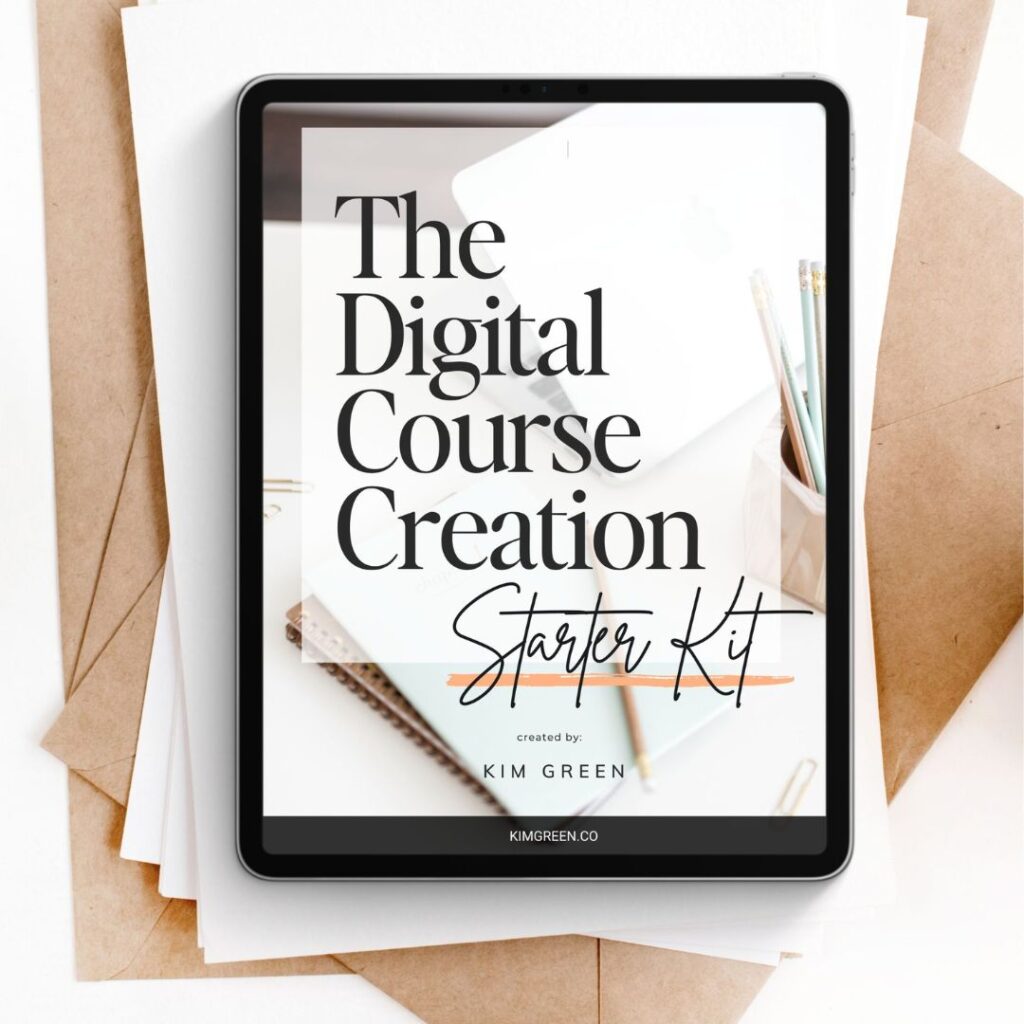Congratulations on embarking on your journey as a digital course creator! One of the most crucial aspects of your course is the content itself. To ensure your students stay engaged, learn effectively, and derive value from your course, it’s important that you create content that is not only informative but also engaging. In this guide, we’ll explore strategies to help you create captivating and impactful course content.
#1: Understand Your Audience

Before you start creating content, it’s essential to understand your target audience. Ask yourself:
- What are their learning preferences?
- What level of expertise do they have in the subject?
- What are their pain points and goals?
Tailoring your content to your audience’s needs and preferences is key to engagement.
Here are three examples of how to apply this:
Example 1: If you’re creating a course on digital marketing targeted at beginners, you should recognize that your audience may have limited prior knowledge. Tailor your content to include foundational concepts and avoid using industry jargon without explanation.
Example 2: For a more advanced audience interested in machine learning, you can assume a higher level of expertise. Your content should delve into complex algorithms, mathematical concepts, and practical applications in real-world scenarios.
Example 3: In a course about healthy cooking for busy parents, consider that your audience may have limited time for meal preparation. Focus on quick and nutritious recipes that cater to their specific needs and challenges.
#2: Start with Clear Learning Objectives

Learning objectives are the foundation of your course content. Clearly define what students should know or be able to do after completing each lesson or module. Learning objectives provide focus and direction for your content creation.
Here are three examples that will help explain how to define your objectives:
Example 1: Learning Objective: “By the end of this module, students will be able to understand the fundamentals of SEO, including keyword research, on-page optimization, and off-page link building.”
Example 2: Learning Objective: “After completing this lesson, students should be able to code a basic Python program that calculates prime numbers using a for loop.”
Example 3: Learning Objective: “Upon finishing this module, participants will be proficient in using project management software to create and manage project schedules, tasks, and teams.”
#3: Use Varied Content Types

Diversity in content types keeps students engaged. Consider incorporating as many of the following as possible:
- Video lectures
- Written materials (ebooks, PDFs)
- Quizzes and assessments
- Interactive assignments
- Infographics
- Case studies
- Live webinars or Q&A sessions
Mixing up content formats can cater to different learning styles and maintain interest.
Take a look at these three examples of how to incorporate different types of content:
Example 1: Include video lectures where you explain marketing strategies, written guides for reference, and interactive quizzes to test students’ knowledge on digital marketing concepts.
Example 2: In a course on photography, use a combination of video tutorials demonstrating camera settings, written guides explaining composition principles, and assignments where students submit their photos for critique.
Example 3: For a leadership development course, incorporate written case studies illustrating leadership challenges, live webinars for discussions and Q&A sessions, and group projects to encourage collaboration.
#4: Organize Content Effectively

Structure your course logically, with a clear flow from one module or lesson to the next. Use headings, subheadings, and bullet points to make written content scannable. Include a table of contents and progress tracking to help students navigate and track their progress.
Here are three examples of how to effectively organize your content:
Example 1: If you’re creating a course on web development, structure it logically, starting with the basics of HTML before moving on to CSS, JavaScript, and more advanced topics like responsive design. This sequential order helps students build a strong foundation.
Example 2: In a course on personal finance, organize modules around key financial life stages, such as budgeting for college, investing for retirement, and managing debt. This clear structure allows students to navigate to the content most relevant to them.
Example 3: For a fitness course, arrange content by workout type, duration, and fitness level. Students can easily find workouts that match their goals, whether it’s weight loss, muscle gain, or improving flexibility.
#5: Maintain Clarity + Simplicity

Avoid jargon and overly complex language. Keep your explanations clear and concise. Be sure to use real-world examples to illustrate concepts and make them relatable to your students.
Take a look at these examples for a demonstration on how to accomplish this:
Example 1: In a course on graphic design, use straightforward explanations when introducing concepts like color theory. Avoid technical terms unless they are essential, and provide real-world examples of how color choices impact design.
Example 2: When teaching a programming language like JavaScript, break down complex code into manageable segments with clear comments and explanations. Use relatable analogies to explain abstract programming concepts.
Example 3: For a course on effective communication, emphasize the importance of using plain language in business emails to avoid misinterpretation. Provide templates and examples of well-structured emails for different scenarios.

Download our free Digital Course Creation Starter Kit – It will make planning your course a breeze!
#6: Encourage Interaction

Foster a sense of community and interaction among your students. Use discussion forums, peer review assignments, or social media groups for students to share their thoughts, ask questions, and engage with one another.
Here are three examples that will help you think through ways to encourage interaction:
Example 1: In a course on gardening, create a discussion forum where students can share their gardening experiences, ask questions, and offer advice to fellow gardeners. This fosters a sense of community and knowledge exchange.
Example 2: For a course on public speaking, include peer review assignments where students record speeches and provide constructive feedback to one another. This interactive approach helps students improve their presentation skills.
Example 3: In a language learning course, organize virtual language exchange sessions where students practice speaking with native speakers or fellow learners. This real-time interaction enhances language acquisition.
#7: Provide Opportunities for Practice

Learning by doing is often more effective than passive consumption. Include exercises, quizzes, and assignments that allow students to apply what they’ve learned. Provide feedback on their work to aid their understanding and improvement.
Let’s look at three examples that demonstrate ways to incorporate practice:
Example 1: In a course on digital marketing, include hands-on exercises where students create and manage their own online advertising campaign. This practical experience reinforces the concepts learned.
Example 2: For a course on financial planning, design budgeting assignments where students create a personal budget based on their income and expenses. Regular practice helps them build financial management skills.
Example 3: In a creative writing course, offer writing prompts and storytelling challenges to inspire students to practice writing in different genres and styles. Regular writing exercises improve their writing abilities.
#8: Use Visuals and Multimedia

Visual elements, such as images, diagrams, and videos, can enhance understanding and retention. Use them strategically to illustrate complex concepts or to break up text-heavy sections.
The types of visual elements you can use are endless. Here are three examples to get your wheels turning:
Example 1: In a course on biology, use animated diagrams and 3D models to illustrate cellular processes and molecular structures. Visualizing complex concepts enhances comprehension.
Example 2: When teaching art history, include high-resolution images and video tours of famous artworks and historical sites. Visual media allows students to explore art in detail.
Example 3: For a course on music theory, incorporate audio clips of musical compositions to help students recognize different musical elements, such as melody, harmony, and rhythm.
#9: Keep Content Up-to-Date

Regularly review and update your course content to ensure it remains relevant. Technology and knowledge evolve, and your course should reflect these changes.
No matter the subject, it will need updating. Here are three examples for you:
Example 1: In a course on digital marketing, regularly update modules to reflect changes in search engine algorithms, social media platforms, and advertising trends.
Example 2: For a course on software development, revise code examples and practices to align with the latest programming languages and best practices.
Example 3: In a course on healthcare administration, stay current with healthcare policies, regulations, and industry standards, and update content accordingly.
#10: Engage with Multimedia

Your presence as an instructor can significantly impact engagement. Use video introductions, personalized welcome messages, and live Q&A sessions to establish a connection with your students.
Take a look at these three examples:
Example 1: Start each module with a brief video introduction where you explain the module’s objectives and why it’s relevant to the overall course. Your enthusiasm and engagement set the tone for the content.
Example 2: Host live Q&A sessions or webinars where students can ask questions and discuss course material in real-time. Interacting directly with the instructor enhances the learning experience.
Example 3: Include video interviews with industry experts or thought leaders who share their insights and experiences related to the course topic. Expert interviews provide additional perspectives and credibility to your content.
#11: Test Your Content

Before launching your course, have a group of beta testers go through it. Gather their feedback and make necessary improvements. This ensures a smoother learning experience for your future students.
Here are three examples of beta testing with real-world scenarios:
Example 1: Before launching a course on software development, invite a group of beta testers to go through the coding exercises and provide feedback on clarity, difficulty, and any technical issues.
b. Example 2: For a course on photography, ask a sample of students to test the camera settings tutorials and provide input on whether the explanations are easy to follow.
c. Example 3: In a course on nutrition, offer a select group of participants a preview of the meal planning section and gather feedback on recipe variety, dietary restrictions, and nutritional information.
#12: Seek Continuous Improvement

Don’t consider your course a finished product after launch. Continuously gather feedback from students, track their progress, and make updates based on their needs and suggestions.
Take a look at these three examples:
Example 1: Regularly review student feedback and update content based on their suggestions and needs. If multiple students request additional resources on a specific topic, consider adding supplementary materials.
Example 2: Analyze course completion rates and quiz scores to identify areas where students may be struggling. Use this data to create supplemental lessons or resources to address these challenges.
Example 3: Monitor discussion forums and social media groups related to your course. Pay attention to common questions and misconceptions, and create new content or FAQs to address these issues.
#13: Balance Depth + Brevity

Strive for a balance between providing in-depth information and keeping lessons concise. Respect your students’ time and attention while ensuring they acquire the necessary knowledge.
Here are three examples of how to accomplish this:
Example 1: In a course on entrepreneurship, provide an in-depth module on creating a business plan for students looking to start their own businesses. However, offer a concise summary and action steps for students who are simply interested in understanding the concept without launching a business.
Example 2: For a course on history, offer both comprehensive lectures for history enthusiasts and shorter, condensed versions of key historical events for those seeking a basic understanding.
Example 3: In a course on graphic design software, create separate lessons: one for beginners, covering the essentials, and another for advanced users, diving into advanced techniques. This allows students to choose their depth of learning.
#14: Be Passionate + Enthusiastic

Your enthusiasm for the subject matter can be contagious. Express your passion in your content, whether through your voice, writing style, or video presentations.
Here are three examples of this in action:
Example 1: If you’re teaching a course on sustainable living, let your passion for environmental conservation shine through in your videos and discussions. Share your personal experiences with eco-friendly practices to inspire your students.
Example 2: In a course on astronomy, express your enthusiasm for the cosmos by discussing recent astronomical discoveries, sharing fascinating facts about the universe, and conveying your love for stargazing.
Example 3: For a course on mindfulness and meditation, infuse your voiceovers with a calming and enthusiastic tone. Share your own mindfulness journey and the positive impact it has had on your life.
The Wrap-Up

Creating engaging course content is an art that requires a deep understanding of your audience and a commitment to delivering value. By following these strategies and continuously refining your content based on student feedback, you’ll be well on your way to creating a digital course that not only imparts knowledge but also keeps students excited and motivated to learn. Good luck with your course creation journey!
Have fun with it!


Download our free Digital Course Creation Starter Kit – It will make planning your course a breeze!